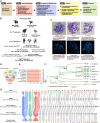Genomic analyses of wild argali, domestic sheep, and their hybrids provide insights into chromosome evolution, phenotypic variation, and germplasm innovation
- PMID: 35948368
- PMCID: PMC9528982
- DOI: 10.1101/gr.276769.122
Genomic analyses of wild argali, domestic sheep, and their hybrids provide insights into chromosome evolution, phenotypic variation, and germplasm innovation
Abstract
Understanding the genetic mechanisms of phenotypic variation in hybrids between domestic animals and their wild relatives may aid germplasm innovation. Here, we report the high-quality genome assemblies of a male Pamir argali (O ammon polii, 2n = 56), a female Tibetan sheep (O aries, 2n = 54), and a male hybrid of Pamir argali and domestic sheep, and the high-throughput sequencing of 425 ovine animals, including the hybrids of argali and domestic sheep. We detected genomic synteny between Chromosome 2 of sheep and two acrocentric chromosomes of argali. We revealed consistent satellite repeats around the chromosome breakpoints, which could have resulted in chromosome fusion. We observed many more hybrids with karyotype 2n = 54 than with 2n = 55, which could be explained by the selfish centromeres, the possible decreased rate of normal/balanced sperm, and the increased incidence of early pregnancy loss in the aneuploid ewes or rams. We identified genes and variants associated with important morphological and production traits (e.g., body weight, cannon circumference, hip height, and tail length) that show significant variations. We revealed a strong selective signature at the mutation (c.334C > A, p.G112W) in TBXT and confirmed its association with tail length among sheep populations of wide geographic and genetic origins. We produced an intercross population of 110 F2 offspring with varied number of vertebrae and validated the causal mutation by whole-genome association analysis. We verified its function using CRISPR-Cas9 genome editing. Our results provide insights into chromosomal speciation and phenotypic evolution and a foundation of genetic variants for the breeding of sheep and other animals.
© 2022 Li et al.; Published by Cold Spring Harbor Laboratory Press.
Figures





References
MeSH terms
LinkOut - more resources
Full Text Sources
Miscellaneous
